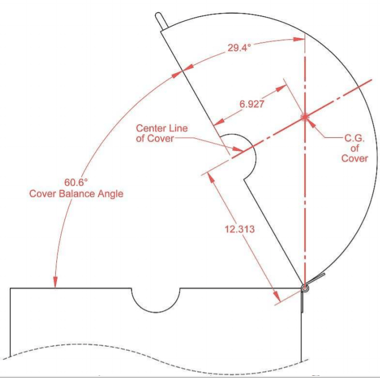
Improving stability.
Upgrading performance.
Enhancing safety.
These are just a few of the reasons a design engineer might find themselves calculating the center of gravity for any object.
In the world of hinge design, this calculation can be used for someone as simple as keeping a lid, door, or cover from slamming into something -- or someone.
Designing a no-slam hinge doesn’t just keep your customers safer, it also keeps you protected … from lawsuits. On a lighter note (pun intended), a steady open/close also improves ease of use for customers.
Finding the center of gravity in objects isn’t always easy; not all objects are perfect circles or simply symmetrical. In fact, most aren’t, and calculating their center of gravity takes a certain level of skill – something an experienced heavy-duty hinge manufacturer possesses.
In this article, we’ll look at three ways (in order of decreasing difficulty) for how to find the center of gravity of an irregular object. Can't wait? Click on any one of the ways to jump to the corresponding section:
 Defining Center of Gravity, Balance & Why They Matter in Hinge Design
Defining Center of Gravity, Balance & Why They Matter in Hinge Design
Before we get into precisely how to find the center of gravity of an irregular object, let’s dig into some of the basic academics for this calculation.
What is Center of Gravity?
Center of gravity is a geometric trait. Simply put, it’s the average location of the weight of an object. Center of mass and center of gravity are the same thing.
We can ID the motion of any object by the shift of its center of gravity from one place to another, and the rotation of a hinged object about its center of gravity.
You need to find your center of gravity in order to find your balance. This is crucial for heavy:
- Doors
- Lids
- Covers
About Balance Point
The balance angle is the number of degrees at which the center of gravity is directly above your pivot. The balance point is the location where the center of gravity should line up directly over the top of the pivot. This is the point at which your cover stays put and won’t swing in either direction.
If the user pushes the lid forward, though, it’ll crash -- unless you have a counterbalance.
The balance point is important because it will help you verify whether you have the correct center of gravity.
Why They Matter in Hinge Design
Why is balance important for hinge design?
It's the point that the whole design hinges on (pun #2). Whether you figure out the center of gravity yourself, or use an app, or let your counterbalance manufacturer help ... it's a must.
Once your hinge manufacturer has your lid’s weight and its center of gravity, it can develop the geometry of your custom counterbalance hinge design. You also need to know these figures to use the Vectis design-your-own hinge app.
[How to] 3 Ways to Find Center of Gravity of an Irregular Object
So, let’s get to how to find the center of gravity of an irregular object. Completing this calculation doesn’t have to be a complicated process – in fact, there are three easy ways to do it.
1. The Easy Way
We refer to the easy method as the intersecting lines method.
Normally, a sheet of paper’s center of gravity doesn’t change, no matter which edge or corner you pick it up by. But if you fold one of the paper’s corners over, the center of gravity shifts because the weight distribution is different.
When figuring out a lid or door’s center, you can hang it by its pivots and draw a straight line down. Then you can hang it by its handle and draw another line. Where those two lines intersect is your center of gravity.
Your hinge manufacturer will need to know the point, both horizontal and vertical, from the main pivot in the closed position to determine the center of gravity.
The Catch
- If your lid is very heavy, you might not be able to use this method.
- Another potential issue lies in the shape of your cover -- think of a tanning bed door. Since it’s a C shape, the center of gravity will be in the middle of the C, where there is no actual door to put your line on. That’s where using CAD software would be easier.
Speaking of which ...
2. The Easier Way
If you’d rather skip the old-fashioned method, you can consult your CAD software model to calculate center of gravity in 3D. If you can change your coordinate positioning to the main pivot in your model, you can get those same dimensions right in SolidWorks or pretty much any other software you use.
In the case of SolidWorks, you can find center of gravity by clicking Center of Mass in the Reference Geometry toolbar, or by heading to Insert > Reference Geometry > Center of Mass.
In the graphics area, you’ll see an icon resembling crosshairs appear at the center of mass of your model. In the FeatureManager tree, center of mass appears below Origin.
The position of your center-of-gravity point updates as you add, move, and delete features in a component.
The Catch
- Simulating a cover is not the same as having the real-life cover on hand. You’ll need to be very careful when specifying material properties (density, grade, etc.).
- If you don’t properly put in the specs above, you probably won't realize it until it’s too late. When your heavy lid or door is manufactured, the perceived quality will be poor. Basically, any sloppiness on your part will set your project back a long, long way.
3. The Easiest Way
The easiest way? Simple -- just send your lid design to a complex-hinge manufacturer.
For example, at Weber Knapp we have a proven method in which we take force readings at different angles. We use that information combined with proprietary software to determine your lid or door designs' center of gravity.
The Catch
- There isn’t one unless you’re insistent on DIYing your counterbalance design. We find customers get far better results when we take the measurements ourselves, but we’ve also shown customers how to do it.
The Risk of Leaving it to Another Engineering Department
Even though they can go on the internet and find plenty of information about the center of gravity, a lot of engineers don’t think it through or truly understand what center of gravity is or why it's important.
This leads into the other major downfall of bad door or lid design: if you mix up your x and y coordinates, you’ll end up with a severely underbalanced design that’ll crash instead of slowly closing. This is a huge injury and liability issue that isn’t worth the risk.
[How to] Take the Headache of out Finding the Center of Gravity of Irregular Objects
Completing this calculation to create a heavy-duty hinge for your product can be incredibly easy for you – just leave it to us and our resources.
If you want to get started the right way with a true no-slam hinge, speak to one of our engineers!
This article was originally published in 2019 and was recently updated to reflect current industry trends.
.png?width=12000&height=2033&name=WeberKnappLogo_white%20(1).png)




